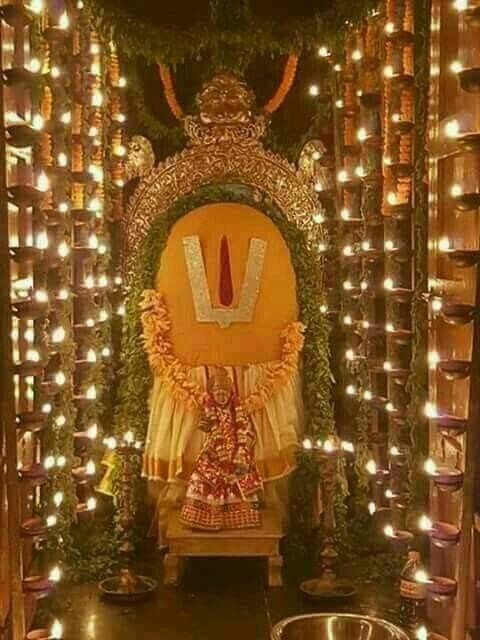
Sri Varaha Lakshmi Narasimha Temple is situated on the Simhachalam Hill, which is about 300 metres above sea level and this temple is dedicated to Lord Varaha Narasimha. Simhachalam is one of the thirty-two Narasimha temples in Andhra Pradesh which are important pilgrimage centres alongside Ahobilam and among others. This Deity has a unique form of Lord Varaha Narasimha appearing generally like a Shiva Linga. This Deity is anointed with sandal wood paste through out the year except on the third day of Vaishaka month – Akshaya Tritiya. This is one of the six unique things happen only on Akshaya Tritiya.
It is said that Lord Narasimha’s fierce nature is soothed by worshipping Him in union with Lord Varaha, who is usually considered as a peaceful Deity. Here Sri Varaha Narasimha is addressed with many names such as Simhadrinatha, Simhadri Appanna and Apparu. Devotees believe that the Deity can give progeny to women and fulfils wishes of devotees.
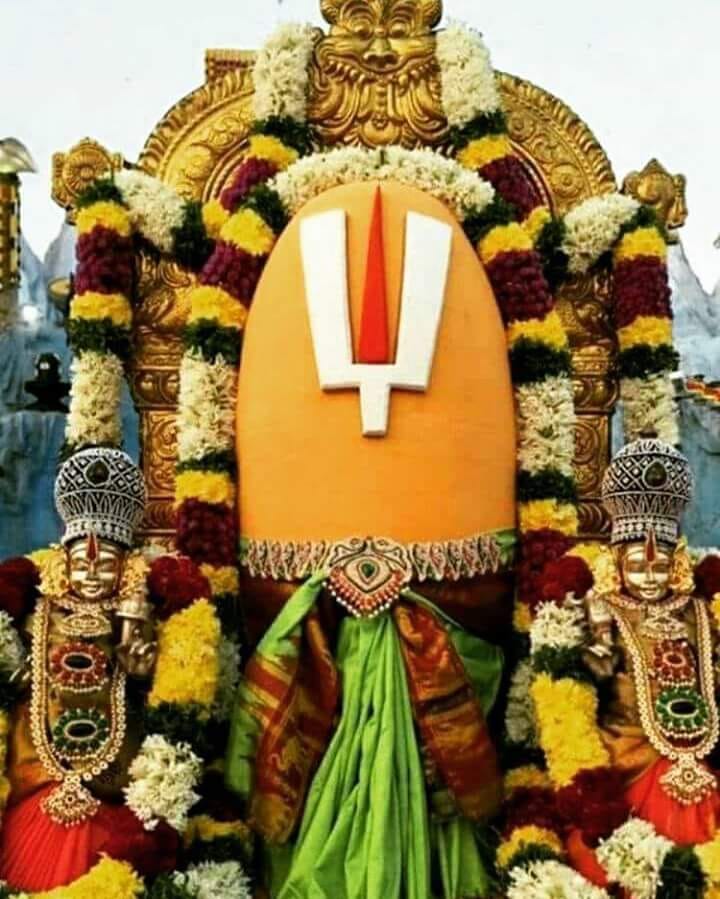
Sri Simhacham Narasimha
Temple History
As per the scriptures preserved in the temple, this shrine was constructed by Bhakta Prahlada in the Krita (Satya) Yuga. At the end of the Krita Yuga, the temple was neglected and began to crumble. Gradually the Deity was covered with crests of earth.
Later in the Treta Yuga, once Emperor Pururava of the Lunar dynasty was travelling in his Pushpaka Vimana, with his wife Urvashi – the heavenly damsel over the hill towards south. Their Vimana was attracted to Simhachalam through a mystic power. He discovered the Deity imbedded on the crests of the earth. He cleared the earth around the Deity but could not find the lotus feet of the Deity. To which a celestial voice appeared and echoed, “The Deity can provide salvation in the current form”. King Pururava reconstructed the temple. Urvashi was instructed in a dream by the Lord that the Deity of Varaha Narasimha should be covered with sandalwood paste for the whole year except on the third day of Vaishaka month – Akshaya Tritiya. This tradition is practiced even today.
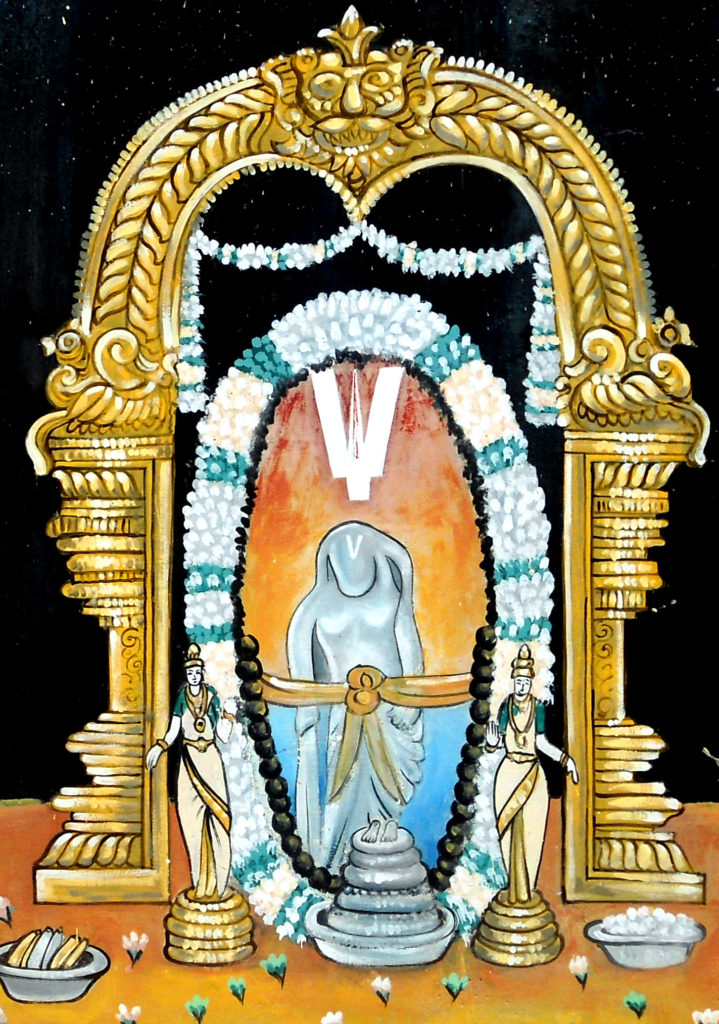
Sri Simhachala Narasimha
Ramanuja’s Visit
In the eleventh century, after triumphing a debate at the Jagannath Puri temple, the Sri Vaishnavite saint and philosopher Sri Ramanujacharya visited Srikurmam and Simhachalam temples. Simhachalam’s Deity was believed to be Shiva primarily due to the Deity’s appearance and many other reasons which further strengthened the beliefs.
Ramanuja argued that the Deity of Varaha Narasimha is in a form in accordance with the Pancharatra Agama rules. Ramanujacharya was able to defeat the intellectuals at Simhachalam and transformed the temple into a Vaishnavite place of worship.
Upon having darshan of Sri Varaha Narasimha’s Deity anointed with sandalwood paste, it resembles a Shiva Linga. Ramanujacharya took personal possession of the temple and ordered the priests to remove the paste. The task began, and before completion the idol started bleeding. Sensing the Deity’s rage for violating the directive, sandalwood paste was reapplied again which stopped the bleeding. They presumed that the Deity wished to appear like a Linga and continued the tradition except for Akshaya Tritiya.
Temple Structure and Architecture
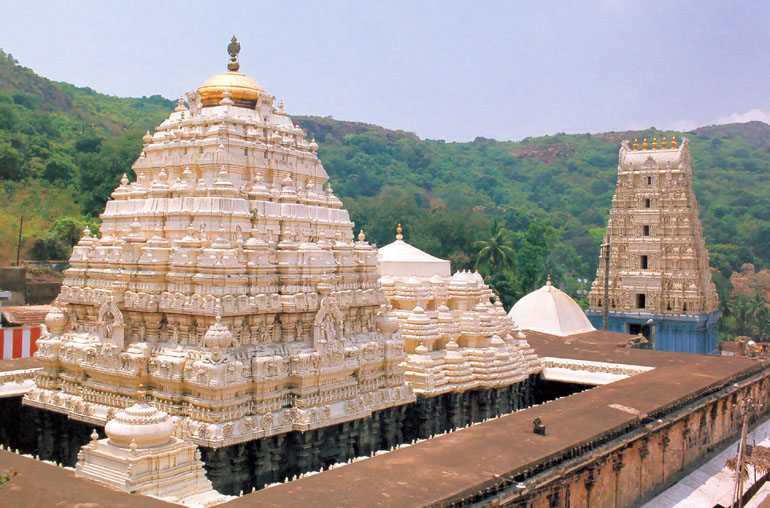
Sri Simhacham Narasimha Temple
Simhachalam temple bears a resemblance to a fort from outside with three prakarams and five gateways. Majority of the temple’s present form was rebuilt by Narasimhadeva I. Its structural design is a blend of Orissan, Chalukya and the Chola styles. The temple faces west – an unusual case in the usual tradition of temple architecture. It is believed that the temple at first faced east but was changed to west due to mysterious reasons. As per the Purushottama Samhita and the Vishnu Samhita scriptures, a temple facing west signifies victory whereas the temples facing east denote prosperity.
Devotees enter the temple through the side door with a stairway of the five-tiered rajagopuram situated on the western gateway leading into the 96 pillared Kalyana mantapa. The Kalyana Mantapa has coloumns and walls on which there are carvings of Lord Vishnu, His consort Lakshmi Devi and the twelve Alwars. Close to the entrance, Chaitanya Mahaprabhu’s (A Gaudiya Vaishnava saint cum incarnation of Radha-Krishna) lotus footprints were installed 1930 by Bhaktisiddhanta Sarasvati Thakur (One of His disciples) can be seen. The Mukha mandapa (main hall), houses a pillar named Kappam Stambham has curative powers. It is consecrated using the Santana Venugopalaswamy Yantra and is known to grant unfulfilled wishes.
The temple also houses two ponds namely – Swami Pushkarini near the temple and Gangadhara at the bottom of the hill.
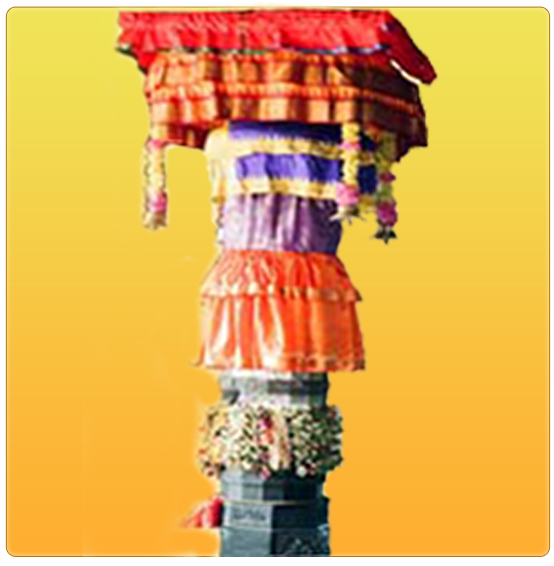
Shrines
The moolavar of Varaha Narasimha is housing in a separate hall named Prahlada mandapa. The Deity stands in a tribhanga (three bent) posture with a boar’s head, a human chest and a lion’s tail. On either side of the Deity, Sridevi and Bhudevi are holding lotus flowers. Varaha Narasimha’s Deity has no ornaments and drapery carved on the body. Its limbs and face are disfigured due to vandalism. The moolavar is covered with sandalwood paste procured from Srivilliputhur, Tamil Nadu. After anointing the sandalwood paste, the moolavar resembles a four feet tall Shiva Linga. There are only four main ornaments used in the temple: a Thirunamam made of diamonds and rubies, a string of emeralds, a 100-tola gold hand-band, and a golden crown.
Sub-Shrines
The temple complex hosts few other sub-shrines. Two of them are dedicated to Andal – one of the twelve Alwars and Mother Lakshmi – Varaha Narasimha’s consort. Here, Mother Lakshmi is referred to as Simhavalli Thayar and Her Deity is in a lotus position with four hands. The fore arms display abhayamudra and varadamudra, and the rear arms hold a pair of lotus flowers. The other eleven Alwars, Ramanujacharya, Manavala Mamunigal and Vishvaksena are housed in separate shrines inside the main complex.
Tripurantaka – Lord Shiva’s manifestation is the kshetrapala (guardian deity) of Simhachalam. The guardian deity is identified with Bhairava, a fierce manifestation of Shiva. Tripurantaka and his consort have a temple dedicated to them situated on the way to Gangadhara.
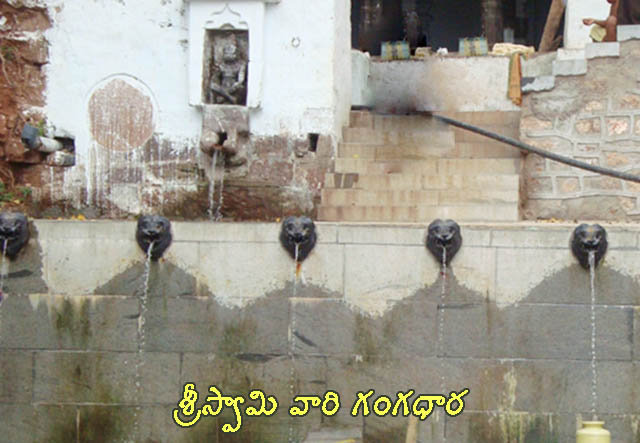
Temple’s Routine Seva
The temple is engaged with religious practices and customs formulated by Sri Ramanujacharya and his followers like Anandalvan. The religious practices are modelled based on the Satvata Samhita, one of the 108 texts of the Pancharatra Agama. There are five metal Deities which serve as the substitute to the moolavar for certain practices. Yogananda Narasimha is the snapana bera (Deity receiving Abhisheka – the ceremonial bath), Govindaraja is the utsava bera (festival Deity), and Sudarshana Chakra is the bali bera (guardian Deity). Madanagopala and Venugopala, two forms of Krishna are the kautuka bera (representative Deity) and the sayana bera (sleeping Deity) respectively.
The deity worship commences in the morning around 5:30 AM. As the sanctum sanctorum of the shrine is opened, the Vayu mantra is rehearsed. The priests chant the Suprabhatam for about an hour and half as a preface to the routine worship activities. It is complemented by people playing nadaswaram, the laghvarchana (preliminary worship) is performed; priests offer jaggery and coconut after which the mangala arati is offered to the Deity. Devotees can visit the sanctum sanctorum from 6:30 AM for the next five hours. The worship continues up to 8:00 AM which consists of shodasha upachara (sixteen services). Abhisheka is performed to the Yogananda Narasimha Deity. The last phase of the morning worship is the Baliharana (pacification ceremony), where a portion of the prasadam is offered to the ashtadiga palakas. Sudarshana Chakra Deity is used in this phase. The morning rituals in the sub-temples follow a similar pattern, with the initial worship and offerings provided in each temple in succession.
After 11:00 AM, the temple’s midday worship begins. After half an hour, rajabhoga (main offering) is offered to the Deity. The pilgrims are not allowed to visit the sanctum for the next half an hour. Rajabhoga consists of cooked rice, dal, cooked vegetables, ghee and curd. Another half an hour break is given to the Deity at 2:30 PM. Devotees are then allowed to visit the sanctum up to 7:00 PM. Evening worship begins at 6:00 PM, with the Divviti Salam (salute with torches) ceremony. Two men go round the temple; one holds a torch and the other plays a drum. The rituals offered in the evening are like that of the morning worship. The importance given to music is the major deviation. Devotees can have a glimpse of the Deity for half an hour from 8:30 PM. At 9:00 PM, shayana seva is performed and the temple closes.
Festivals Celebrated
The festivals celebrated in the temple are based on the Dravida Sampradaya – the customs followed in Tamil Nadu. The festivals are celebrated at a time regulated by the Suryamaana (sun-centric) system followed in Tamil Nadu, unlike that of Andhra Pradesh which follows Chandramaana (lunar-centric) system.
Kalyanotsava and Chandanotsava are the two most important annual festivals celebrated in the temple, among others.
Kalyanotsava
Kalyanotsava is the celestial marriage of Lord Vishnu with His consort Lakshmi Devi, celebrated in every Vishnu temple. The celestial marriage is an event to behold by a devotee. Kalyanotsava of Varaha Narasimha, is celebrated on the 11th day of the Chaitra month. The five-day festival celebrated is scripted dated 1401 records the gift of a flag staff named the Garudaroha Kamba for celebrating the Divya mahotsavas on the fifth day of the bright fortnight of the Chaitra month. Due to which Kalyanotsava is considered as the mahotsava of Simhachalam.
Chandanotsav
Chandanotsav is also known as Chandan Yatra, it is the most important festival celebrated in the temple. This festival is celebrated on the auspicious day of Akshaya Tritiya in accordance with the temple’s history. On this day, the sandalwood paste is removed from the moolavar Deity and devotees can have Nijarupa darshan – the original form of the Deity for twelve hours of the day.
The sandalwood paste is applied to the Deity on four days in a year: on Akshaya Tritiya and full moon days of the Vaisakha, Jyeshta, and Ashadha months.
Every time, four manugus (1) of sandalwood paste is applied. The sandalwood paste that covers the Deity is removed early in the morning at 4:00 AM. The prayers and abhisheka are completed by 6:00 AM after which the devotees are let to enter the sanctum to have nija rupa darshan – the original form of the Deity.
The evening ceremony begins with several bathing services to the moolavar; the prominent ones are Chandanabhisheka (abhisheka with water mixed with sandalwood powder) and Sahasrakalasabhisheka (abhisheka with water from thousand metal pots). All the three food offerings (Balabhoga, Rajabhoga, and night offering) are served to the Deity at a time to compensate their omission during the day.

Chandanotsav
Kamadahana
This is another important festival celebrated in the temple on the full moon day of Phalguna month (Holi). This festival is celebrated as an ancillary festival (not specified by ancient texts) of the temple. Followers of Sri Vaishnavism consider Kamadahana as a self-purification ceremony; it is in no relation with the lila of Shiva burning Kamadeva to ashes. Dolotsava is performed as a prelude to Kamadahana on the same day. It is celebrated to mark the death of the demon Holika. The importance given to this festival resembles the impact of Orissan culture in Simhachalam.
The festivities begin in the afternoon as the utsava Deity is brought to the garden located at the foothills. The Deity is throne on a special asana and offered Kumkum with special prayers offered in hymns known as Churnotsavam. The Deity is then seated on a swing and are moved gently in a ceremonial way.
The Kamadahana ceremony commences at 8:00 PM at a small hut built near the entrance of the temple. The hut houses the Deity as the priests conduct a fire ceremony. They offer sacrifices in an extravagant method to burn every aspect of desire. The hut is then burnt, symbolizing the annihilation of Kama (desire).
Other Festivals
Apart from the above-mentioned festivals, the other festivals celebrated in the temple are Narasimha Jayanti, Navaratrotsava, Krishna Janmashtami, Deepavali, Giripradakshina and many more.
Temple Activities
The temple is abuzz with social and welfare activities such as maintaining goshala, serving prasadam in their Annadanam dining hall, maintaining forest, flower gardens, Aagama Pathashala and running an aided Sanskrit school. The temple also facilitates various public utilities like Yoga & Naturopathy Hospital in coordination with SVYSA, Banglore. Complimentary and paid (PAC) Pilgrimage Accommodation Centre buildings and convention halls, are available at nominal rates.
How to Reach
Simhachalam Temple is well connected by airway, roadways, and railways. The nearest Railway Station is Visakhapatnam Railway Station, from which it is about 21 kms. The nearest airport is Visakhapatnam Airport from which it is about 14 kms. The airport is well connected with flights from all major cities. Upon reaching the temple foothills, one must ascend the hill for approximately two hundred steps.
(1) Each manugu is approximately equal to 24 pounds – a measurement in Telugu language.
0

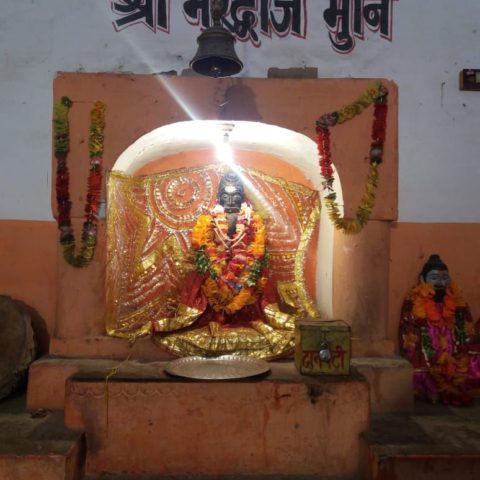
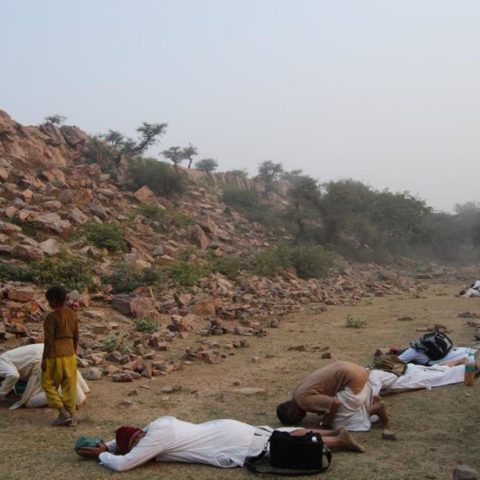
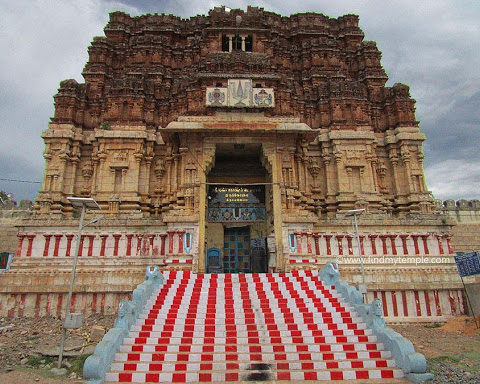










Leave a Reply